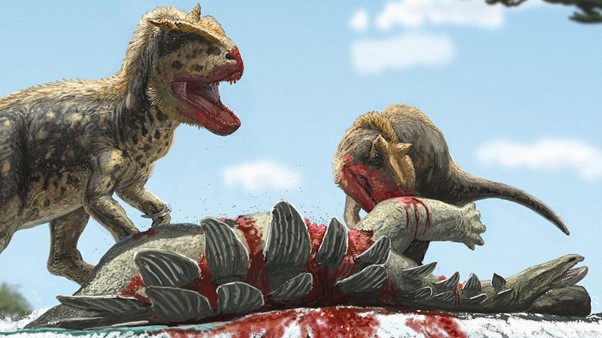Mrigakshi Dixit
A new dinosaur fossil has been identified as the distant cousin of the fearsome Tyrannosaurus Rex. This newly identified theropod dinosaur once roamed parts of Kyrgyzstan, Central Asia around 165 million years ago.
The new fossil species has been named Alpkarakush kyrgyzicus. One of Alpkarakush’s most striking features is its unusual “eyebrow” bone, which most likely held a horn.
This prehistoric beast, about 8-9 meters long, ruled the Jurassic Period.
Well-preserved remains
Back in 2006, Kyrgyz paleontologist Aizek Bakirov unearthed the fossilized remains from the Balabansai Formation, a geological formation located in the mountainous desert near Tashkumyr, western Kyrgyzstan. The strata of this Formation date back to the Middle Jurassic era, around 165 million years ago.
Paleontologists from the Natural History Museum in Bamberg studied the predatory dinosaur specimen.
The fossilized remains consisted of skull bones, dorsal and pelvic vertebrae, fragmentary shoulder girdle and forelimbs, and a nearly complete pelvic girdle and hind limbs.
 Reconstruction of Alpkarakush kyrgyzicus. Joschua Knüppe.
Reconstruction of Alpkarakush kyrgyzicus. Joschua Knüppe.
“Particularly impressive is its extremely protruding “eyebrow” on the so-called postorbital bone, a skull bone behind the eye-opening, which indicates the presence of a horn at that point,” the press release noted.
Anatomical analysis placed this new species within the metriacanthosaurid clade. The species may be a close relative of the large carnivorous dinosaurs that once dominated East Asia.
With this discovery, the study’s authors hypothesize that metriacanthosaurids and other theropod lineages originated in Southeast Asia. Later, these dinosaurs moved to other continents via Central Asia and Europe.
First theropod found in Kyrgyzstan
Alpkarakush is the first theropod dinosaur unearthed in Kyrgyzstan.
Theropods, a dominant dinosaur group, consist of iconic predators like Tyrannosaurus and Allosaurus. It even includes the modern birds we see today.
Allosaurus stalked the Jurassic terrain of North America and southwestern Europe, while the similarly fearsome Metriacanthosaurs lived in China.
However, the region between central Europe and East Asia presented a gap in the Jurassic fossil record. The lack of large Jurassic predatory dinosaur discoveries in this vast area had long puzzled experts.
With this new discovery, paleontologists may be able to put together the missing knowledge.
“This discovery closes a huge gap in our knowledge of the Jurassic theropods. It leads us to important new insights into the evolution and biogeography of these animals,” said Prof. Oliver Rauhut from the Bavarian Collection of Paleontology and Geology in Munich (SNSB-BSPG) and the first author of the study.
Interestingly, a second, smaller Alpkarakush kyrgyzicus specimen was found at the same location. The internal bone structure analysis revealed that the bigger specimen was almost adult, at least 17 years old, but the smaller specimen was a juvenile. It’s possible that a parent animal was accompanied by its offspring 165 million years ago.
High-quality 3D models of Alpkarakush bones created using digital photogrammetry are now available online for scholars worldwide to analyze. /// nCa, 23 August 2024 (cross post from Interesting Engineering)